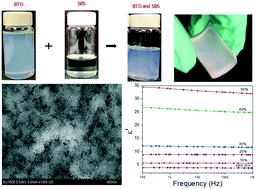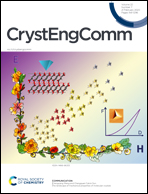Dielectric properties of solution-processed BaTiO3–styrene butadiene styrene nanocomposite films†
Abstract
Polymer–ceramic nanocomposite films consisting of ceramic nanoparticles dispersed into a polymer matrix (0–3 composites) have garnered increasing interest due to their superior performance characteristics, which can be used in flexible modern electronics and energy storage systems. This work reports on the rational design of substrate-free polymer ceramic nanocomposite films consisting of differently sized (10 nm and 20 nm), oleic acid-coated BaTiO3 colloidal nanocrystals dispersed into styrene butadiene styrene (SBS) by using a highly reliable solution-based method. The amount of filler nanoparticles was varied from 0 to 50 wt% and the resulting films preserved their original mechanical properties, without signs of brittleness or defects. The effect of the size and weight fraction of the filler nanoparticles on the morphology and the dielectric properties of the BTO–SBS nanocomposite films was systematically investigated. Electron microscopy images showed that the filler nanoparticles are uniformly distributed within the SBS matrix with a substantial decrease of the interparticle distance within the elastomer matrix when the filler content was varied from 10 to 50 wt%. Room temperature dielectric spectroscopy data showed that the dielectric constant of the SBS elastomer improved significantly (from ε = 4 to ε = 34.3 and ε = 33.7 upon incorporating 10 nm and 20 nm BaTiO3 nanocubes). The breakdown field values were found to decrease from 195 kV cm−1 for the neat elastomer to 15 kV cm−1 for the SBS–BTO nanocomposite films with 50% (wt) filler nanoparticles. The experimental results show that these nanocomposite thin films exhibit superior properties, which make them attractive for implementation in high-performance capacitive storage devices, wearable technology, sensors and nanoelectronics. The results show that the nanocomposite films fabricated by the proposed approach present high permittivity values along with excellent mechanical properties and can be potentially used in energy storage applications.



 Please wait while we load your content...
Please wait while we load your content...